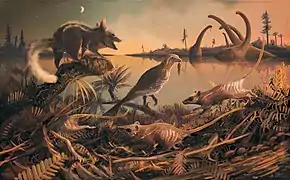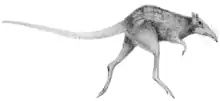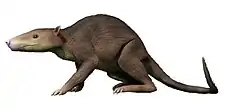Durlstodon
Durlstodon is a genus of extinct mammal from the Early Cretaceous of Southern England. It contains a single species, Durlstodon ensomi, which is known from molars found in the Berriasian Lulworth Formation of Durlston Bay, Dorset, after which the genus was named. The species name honours Paul Ensom, discoverer of many fossil mammals from Lulworth. Durlstodon and two of its contemporaries, Tribactonodon and Durlstotherium, had tribosphenidan (three-cusped) molars, which are an advanced characteristic among eutherian mammals and suggest that the group emerged earlier than the Early Cretaceous.[1]

Artist's impression of Durlstotherium (right and center) and Durlstodon (left)
| Durlstodon Temporal range: | |
|---|---|
 | |
| Molars of Durlstotherium newmani (A) and Durlstodon ensomi (B) | |
| Scientific classification | |
| Domain: | Eukaryota |
| Kingdom: | Animalia |
| Phylum: | Chordata |
| Class: | Mammalia |
| Clade: | Eutheria |
| Genus: | †Durlstodon Sweetman et al., 2017[1] |
| Type species | |
| †Durlstodon ensomi Sweetman et al., 2017[1] | |
References
- Sweetman, S.C.; Smith, G.; Martill, D.M. (2017). "Highly derived eutherian mammals from the earliest Cretaceous of southern Britain". Acta Palaeontologica Polonica. 62 (4): 657–665. doi:10.4202/app.00408.2017.
This article is issued from Wikipedia. The text is licensed under Creative Commons - Attribution - Sharealike. Additional terms may apply for the media files.


